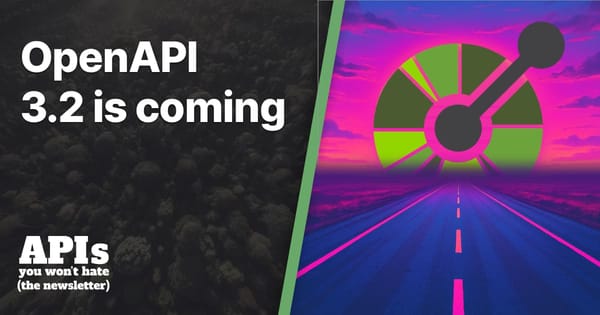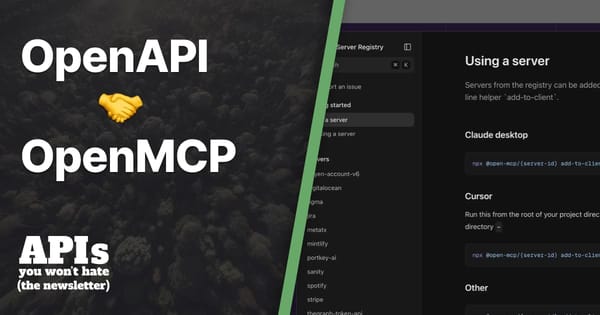Making the Most of JSON:API

With JSON:API, HAL, and other compound document formats
becoming less necessary thanks to
HTTP/2, using these
formats is no longer a given.
That said, there are plenty of reasons for some teams to continue using JSON:API for the near future:
- Existing APIs with an underlying codebase tightly coupled to JSON:API, that cannot serialize multiple formats
- Teams that are all very used to JSON:API and are on tight deadlines to deliver a working solution
- APIs that are consumed in the browser, especially those which need support for mobile browsers, or operating systems older than Windows 10, or OS X 10.11 (source)
Let's look at a few of the problems I've hit using JSON:API in production for two years.
Scope for Compound Documents
At a carpooling company, with trips which could contain many riders. We exposed
/trips?include=riders and everything was great, until the web and iOS clients
let us know months later they'd been filtering on the client side to map only
active riders.
Client-side filtering is a concern as it overworks the application server and
database server. It also forces clients to wait on unnecessary data to
transferred over the network, and makes the browser use more juice than it needs
to.
Some developers thought it was obvious to restrict the "riders” relationship to
only "active riders”, and pushed code to make that happen. It turns out that
broke the Android client, which actually had a Previous Riders screen and was
expecting the "riders” relationship to have all statuses not just active.
My suggestion was to deprecate the riders include, and create active_riders
and inactive_riders includes, a trend which we continued throughout the life
of that API.
Avoiding default scopes is important, as the "default” for one application might
be different to another. Don't try to assume what default scopes should be for
ever client, just make it very clear what relationships have scope by putting it
in the name.
"relationships": {
"active_riders": {
"data": [
{ "type": "people", "id": "1" }
]
},
"inactive_riders": {
"data": [
{ "type": "people", "id": "2" },
{ "type": "people", "id": "3" },
{ "type": "people", "id": "4" }
]
},
"pending_riders": {
"data": [
{ "type": "people", "id": "10" }
]
}
}
This avoids the trouble of expectation not matching reality, avoids accidental
changes to reality, and makes it very clear what you're getting.
So long as you're careful to handle this code on the backend, and you're able to
fetch your data in a way that isn't now three times slower. If you're querying a
database for example, you need to avoid temptation to make three separate extra
queries:
... WHERE status = active... WHERE status = inactive... WHERE status = pending
If you can avoid doing that, performance should not suffer too badly from
multiple relationships. Basically you need to fetch everything then split it
yourself, which… is what we were trying to avoid all the clients doing. At least
adding HTTP headers will help clients hopefully cache that
result.
Some people try solve this in another way: filtering relationships.
Filtering Relationships
If by default the whole relationship is everything, most SQL-minded API
developers will then think: I need a WHERE clause. JSON:API doesn't really
provide anything for this, but does suggest using a query string parameter
called ?filter=.
The spec is extremely vague about filtering:
The
filterquery parameter is reserved for filtering data. Servers and clients SHOULD use this key for filtering operations.Note: JSON:API is agnostic about the strategies supported by a server. The
filterquery parameter can be used as the basis for any number of filtering strategies.
That's all the spec says, but various conventions exist. The most popular
suggest is filter[riders][status]=active, which takes the relationship as the
first array key, then the resource field as the next key, before finally taking
the value.
Filtering like this is not so bad when it's a tightly controlled whitelist of
possible fields, but many folks implementing JSON:API get a bit carried away and
allow anyone to filter by anything. This is rather common with SQL-minded
developers, but an API should not be treated like an SQL database, especially if
you're handing out API keys to developers who could perform query-like requests
that you don't know about.
Allowing people to filter by any field on any relationship on a API collection
that's pulling from a database would lead to slow queries. It's impossible to
know which indexes to add ahead of time. The first rule of API development is
"Clients will surprise you." Trying to index everything is damaging to
performance
in a bunch of ways.
Restricting the ways in which clients can filter is a good idea, and optimize
the ways in which they do. As clients request further filters, weigh it up, and
maybe add it if you think it's a good idea.
It's a little tough to code and document these nested filter options, but you'll
need to figure it out, or suffer from awful performance.
Limitations on Relationships
Another tricky choice, is figuring out how many items you put into a
relationship. Do you put 10? 100? Literally all of them?
At first you'll say "Oh there wont ever be more than X”, and again, that's
almost certainly going to change since that initial assumption. The carpooling
company said "Oh there's never going to be more than 5 riders, because a car
wont fit more than 5!"
Then we added vans with 20 riders, and im sure at some point there would have
been actual buses with 100. After a few months there could be several hundreds
of riders with various status, and that's getting to be some chunky JSON.
JSON:API offers fantastic advice in the Pagination
section:
A server MAY provide links to traverse a paginated data set ("pagination links”).
Pagination links MUST appear in the links object that corresponds to a collection. To paginate the primary data, supply pagination links in the top-level
linksobject. To paginate an included collection returned in a compound document, supply pagination links in the corresponding links object.
Basically they recommend shoving some "next" links in there.
"relationships": {
"active_riders": {
"links": {
"related": "https://api.example.com/riders?trip_id=23124"
"next": "https://api.example.com/riders?trip_id=23124&cursor=learn-about-cursors-in-the-book"
}
"data": [
{ "type": "people", "id": "11" },
{ "type": "people", "id": "2819" },
{ "type": "people", "id": "3223" },
{ "type": "people", "id": "36" },
{ "type": "people", "id": "643" },
{ "type": "people", "id": "3434" },
{ "type": "people", "id": "232" },
{ "type": "people", "id": "1123" },
{ "type": "people", "id": "1563" },
{ "type": "people", "id": "1357" }
]
}
}
Ooo, links. Otherwise known as HATEOAS! Hypermedia as the Engine of Application
State which in its most simple form often is "Hey you can go and get more stuff
over here if you want it."
Putting in just a few items for the relationship (say… 10!), then having a URL
for clients to fetch more stuff if they want it is awesome. They can go grab
that either when the end user wants it, or preemptively.
This is a lovely combination of two approaches. On one side its exactly the sort
of thing the REST is asking you to do, whilst still providing a bit of an
optimization for HTTP/1.1-stuck clients scared to make multiple requests.
You do of course need to make sure you have that /riders?trip_id=23124
endpoint, and you'll probably need to make sure you have all the same query
string filter options as you do with filter[riders][status].
By the time you have all these things done twice, you start to wonder if it
would be better to have just the one way of doing things… and that's where I'm
at these days.
I advice against using includes, and if you do use them you need to really
restrict how and where you use them, and also put links in for all of your
relationships, pagination, related actions, and anywhere else that makes sense.
Summary
For those really set on using JSON:API, watch out for these troubles I've bumped
into, and check out other articles by other smart
folks
who are getting into it.
Avoid building a slow SQL-over-HTTP API, that appears to works for a few months,
and fails horribly once your database tables are a little better stocked than
your test data. Sure it'll fulfill any query that anyone could possibly want,
but it'll do it poorly. 😅
One cool thing about using JSON:API for now, is that you can offer includes
and links. Then you can slowly move over to a more hypermedia based approach
as HTTP/2 usage becomes more prolific; deprecating and removing includes as
clients upgrade to just making web requests to nice, HTTP-level cacheable
collections, with top level query strings and no messy compound document stuff
getting in the way.
Personally I want to ditch compound
documents,
pass most of the work off to HTTP/2, RFC
7807, RFC
7386, JSON
HyperSchema, and
maybe knock up a baaaasic little micro-standard that just covers items,
collections, and a handful of little bits of metadata like pagination, sorting,
filters, etc., but that's a topic for another day.





